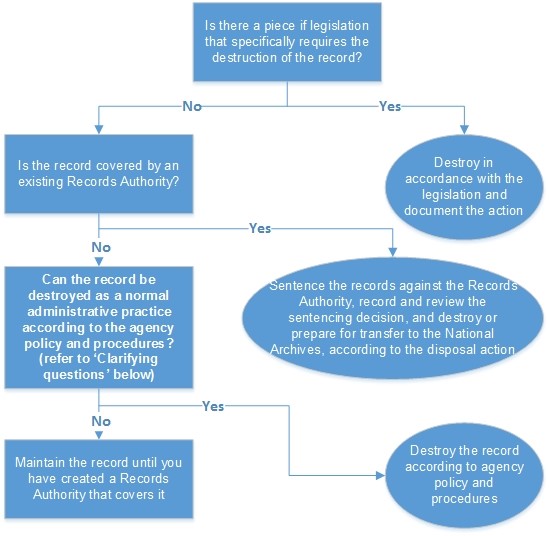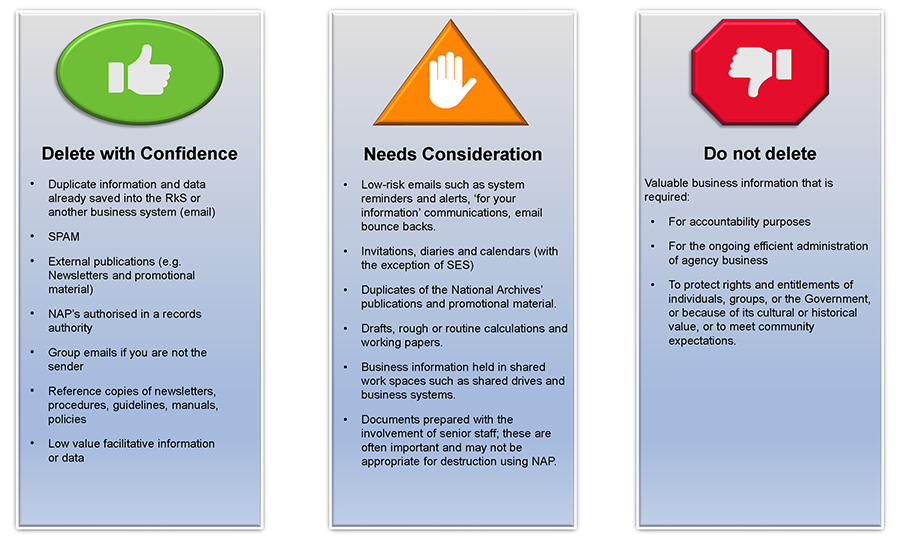A normal administrative practice (NAP) is a process that allows agencies to destroy certain types of low-value and short-term information in the normal course of business.
Business information that is not needed to document your agency’s business can be destroyed in accordance with a NAP without formal permission from the National Archives.
A NAP lets your agency reduce the amount of unnecessary information it holds and, as a result, save on storage costs. It is an important tool for agencies to manage their information efficiently and accountably.
What is a normal administrative practice?
The Archives Act 1983 states that Commonwealth records can be destroyed either:
- as required by a specific law
- with the permission of the National Archives or in accordance with a practice or procedure approved by the National Archives (such as a records authority)
- in accordance with a normal administrative practice.
By letting staff and contractors routinely destroy certain types of information, a NAP helps agencies manage information efficiently while meeting the requirements of the Archives Act.
A NAP sits alongside the formal disposal permissions outlined in agency-specific and general records authorities. It cannot be used to dispose of business information that is covered (or should be covered) by a records authority.
The National Archives’ role
The National Archives:
- provides advice on the sections of the Archives Act 1983 that cover the retention and destruction of records
- provides practical guidance on using a NAP to manage business information
- provides advice to help agencies develop and implement their own NAP policy
- ensures that its web advice on NAP is reviewed regularly
- provides updates on information management issues that affect the use of NAP.
The National Archives is not responsible for authorising the destruction of information in accordance with a NAP.
Your agency’s role
Agencies are accountable for decisions they make about managing their information.
Clearly documented and easily accessible policies and procedures can help your agency explain information management decisions and actions. These policies and procedures need to be endorsed by senior management and communicated formally to all staff. You should also provide appropriate training on their use.
Agencies are different, so a NAP for one agency might not be normal practice for another.
Records authorities and NAP
Records authorities are the main instrument authorising the disposal of business information.
Records authorities cover business information that is required:
- for accountability purposes and to support decision making
- to protect the rights and entitlements of individuals, groups or the government
- to meet community expectations.
Business information may only be considered for destruction using a NAP where that information is not covered – and doesn’t need to be covered – under a records authority.
Information that falls into the categories above which does not have disposal coverage must be retained until it is covered under an agency-specific records authority issued by the National Archives. A gap in your agency’s records authority disposal coverage does not mean you should use a NAP.
Types of information covered under a NAP
Information that isn’t needed to document your agency’s business can be considered for destruction using a NAP. This information usually consists of:
- transitory material or short-term items
- copies/duplicates
- externally published material
- unofficial information.
Information that can be considered for destruction using a NAP will vary between agencies. Agencies should decide which information to destroy under a NAP based on their business context and risks.
Transitory or short-term items
Examples of transitory or short-term items that can be considered for destruction are:
- empty files or folders (with no content, zero-length files) that were created in error, or were created for a proposed project or action that did not occur
- routine correspondence and informal communications that do not support or contribute to administrative or operational functions, such as ‘with compliments’ slips or mailing list messages
- low-risk email such as:
- system reminders
- alerts
- bounce backs
- ‘for your information’ messages where the recipient is not required to take any action
- parts of an email thread where the full thread is saved in an electronic document and records management system
- emails that were sent to multiple recipients, where someone else is responsible for capturing the message into a records management system
- invitations, calendars and appointment diaries, excluding diaries used to record important matters or belonging to high-level staff member such as an agency head
- unused forms.
Copies kept for reference only
Examples of reference information that can be considered for destruction are:
- copies made purely for reference or to support the development of other documents. This includes summaries or extracts of documents held in the agency’s records management system or another business information system
- carbon copies (cc) or blind carbon copies (bcc) kept for convenience
- non-master copies of:
- agency instructions
- circulars
- policies
- procedures
- guidelines
- manuals
- internal newsletters.
Duplicates
Examples of duplicate information that can be considered for destruction are:
- documents or other information that has already been saved into the agency’s records management system or another business information system
- email that has already been saved into the agency’s electronic document and records management system or another business information system
- duplicates of publications and promotional material. The area responsible for a publication is responsible for keeping a master copy.
Rough working papers and calculations
Examples of working papers and calculations that can be considered for destruction are:
- routine or rough calculations
- working papers or background notes used to develop drafts
- spreadsheets or word processing documents that have been incorporated into correspondence or a separate final document
- system printouts or versions used to verify data or answer queries that are not part of regular reporting procedures and are not required for ongoing use.
Drafts not intended for further use
Digital or hard-copy drafts of documents can be considered for destruction if they:
- do not contain significant or substantial changes or annotations
- are not required to document business activities.
Externally published material and unofficial information
Examples of external information that can be considered for destruction are:
- promotional or advertising material sent to your agency
- external publications and catalogues
- unsolicited letters offering goods or services
- unsolicited email (spam)
- unofficial personal email.
When to use NAP
This flowchart can help you decide when to destroy information under a NAP.
NAP (Normal Administrative Practice) can be used to destroy certain information and data when it is no longer required for business purposes. NAP applies to all information and data: emails; documents.



